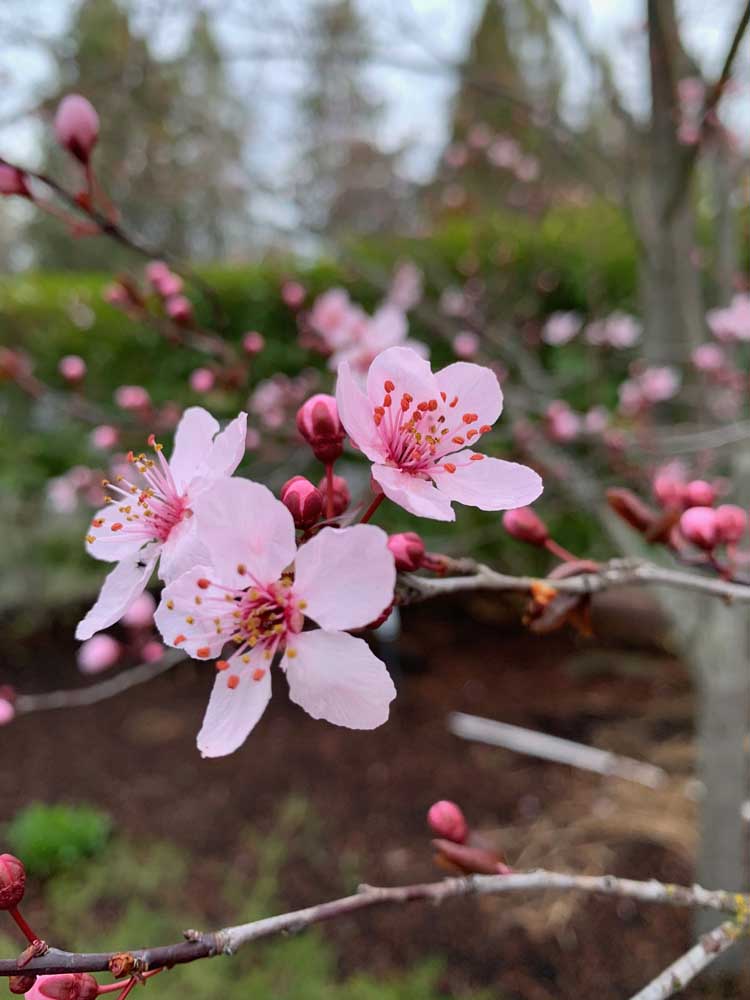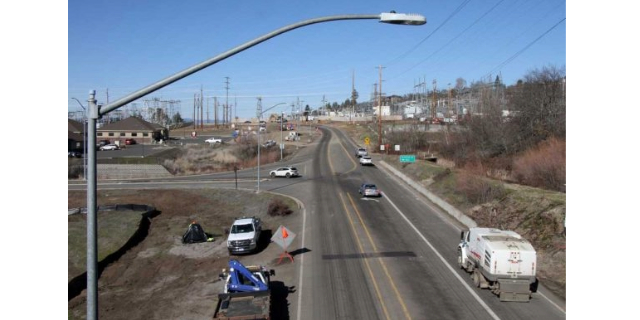GARDEN PLOTS: Climate change considerations for local fruit tree growers
Published 7:00 am Wednesday, February 21, 2024

- Plum trees are one of the first fruit trees to bloom in the Rogue Valley. Pictured are plum tree blossoms that are emerging in the author’s yard.
“We love our fruit trees, and for many of us, a garden is not complete without a fruit tree or two. Yet, perhaps surprisingly, our precious trees and their fruits are under increased threat from a changing climate, loss of pollinators, and a rapidly multiplying number of pests and diseases.”
Trending
— Sally Morgan and Kim Stoddart, “The Climate Change Garden: Down to Earth Advice for Growing a Resilient Garden,” 2023
Driving around the Rogue Valley this week, I’ve noticed many pink- and white-flowered plum trees in bloom. Their shot of color gives me a little thrill because I know plum trees are one of the first fruit trees to blossom in our area and that means springtime is not too far off on the horizon.
Historically, the period between mid-January and mid-February has been our “false spring,” a short window of warmer temperatures that revert back to typical winter weather in late February and March. As an early bloomer, plum trees are well known for their vulnerability to late freezes and low pollination rates, so the fact that they’re blooming in mid-February could spell trouble for crop yields later on.
Trending
However, as climate change progresses, our so-called false springs are more likely to lead directly to average springtime climes with fewer instances of freezes in March and April. This could mean that early-blooming fruit trees like plums won’t have to contend with frozen buds and flowers, and the warmer weather could draw native orchard pollinators like bumblebees and mason bees out of their nests and cocoons sooner.
This all sounds like good news, which is nice to hear in a discussion about climate change. Yet, Sally Morgan and Kim Stoddart caution fruit tree growers about the effects of milder winters.
As it turns out, many kinds of fruit trees require a relatively long period of chilly weather (when temperatures are between 32- and 45 degrees F) while the tree is dormant in order to produce a good crop of fruit. Failure to accumulate enough chill hours (also called vernalization) impacts flowering by reducing the tree’s production of hormones that signal bloom time after the vernalization requirement is met. In turn, a less robust bloom affects fruit set and production.
Temperatures below 32 degrees do not count toward vernalization requirements, and the number of hours when temperatures rise above 60 degrees are subtracted from accumulated chill hours. So far this year, Medford has had at least five days when temperatures were 60 degrees or higher, and this warming trend is expected to increase under climate change.
Whereas many plum, apple and pear varieties require a higher number of chill hours (between 500 and 1,000 hours), other fruit trees, such as peaches, persimmons, figs, grapes and pomegranates require considerably fewer chill hours (between 100-300 hours). Different varieties of the same kind of fruit have widely disparate vernalization requirements. For example, whereas Red Delicious apples require 800-900 chill hours, Fuji, Granny Smith and Pink Lady apples require only 400 chill hours.
Fruit tree growers with an eye toward a warmer future might want to consider investing in fruit tree varieties that need fewer chill hours. I found a website at homesteadandchill.com/fruit-tree-chill-hours-chart that provides a helpful chart of fruit tree varieties and their vernalization requirements, as well as map tools that estimate the number of accumulated chill hours by region. The closest monitoring station to Medford that I found online is in Montague, California (a distance of 54 miles) which, according to the UC Davis calculator, accumulated 1,541 chill hours between September 20 and February 18. Of course, this doesn’t figure in microclimates, but it’s safe to assume, for now anyway, that our fruit trees are getting the number of chill hours they need for optimal production.
This could change if global warming increases 1.5 degrees C (2.7 degrees F), as climate scientists anticipate, during the next 10 years. According to NASA, winter temperature extremes will be warmer by 10-14 degrees F, so the number of chill hours will be significantly reduced.
More worrisome right now is the impact of warmer winter weather on insect pests. I noticed more insects in my winter vegetable garden this year because warmer average temperatures have enabled them to survive in the soil and on the plants. This means insect pests that commonly plague fruit trees, like coddling moths, peachtree borers, leafhoppers, leafrollers and Japanese beetles could become more active earlier in the spring just as leaves and flower buds are emerging.
Organic gardeners should use a variety of strategies to keep fruit trees healthy, so they are better able to combat insect pests. This means planting trees in the right location, keeping the soil nutrient-rich and moist, pruning to allow sunlight and air to circulate through the branches, planting flowers nearby that attract beneficial insects, and planting different types of fruit trees to confuse insect pests (but don’t forget that many fruit trees need pollination between two or more trees with similar bloom times and compatible pollen).
Bacterial and fungal diseases common to fruit trees, such as fire blight, leaf spot, cankers, scab and peachleaf curl are better able to survive and spread rapidly under warmer winter and spring conditions. If you don’t want to use copper or sulfur sprays on your fruit trees, the best strategy is to plant disease-resistant varieties. I found a useful listing of disease-resistant fruit trees at waldeneffect.org/blog/disease-resistant_fruit_varieties.
Morgan and Stoddart remind us in “The Climate Change Garden” that building resiliency in our growing spaces is the key to adapting to warmer temperatures. Factors like chill hours and winter/early spring pests that we haven’t had to think much about before will become more important considerations as global temperatures move closer to the 1.5 degrees C benchmark (we’re at 1.1 degrees C now).









